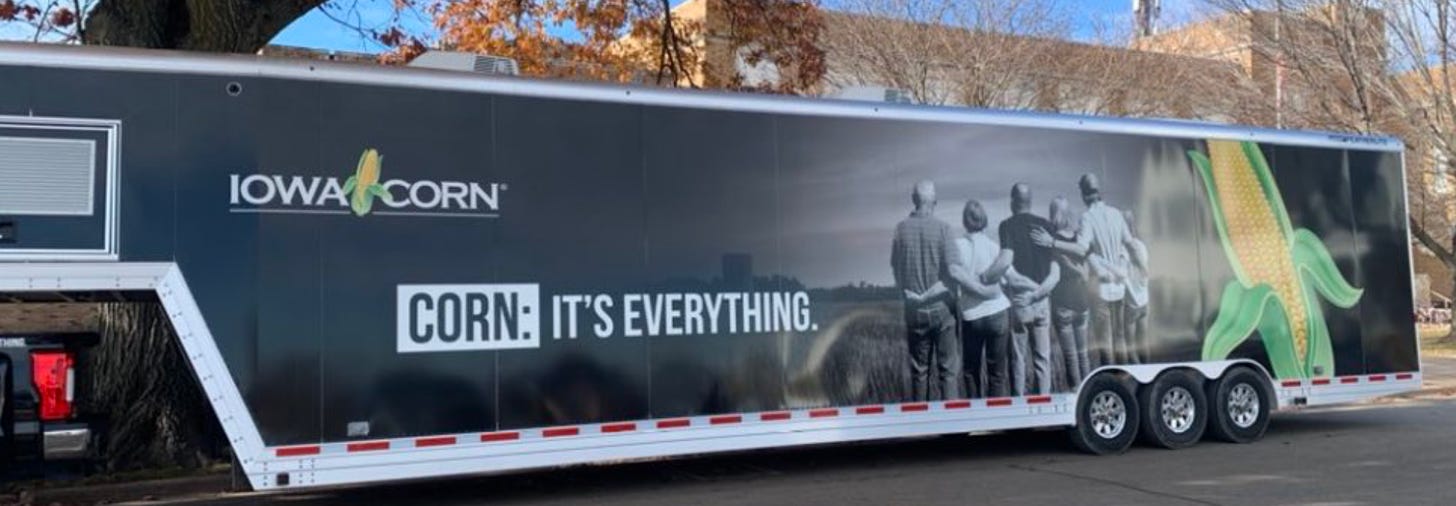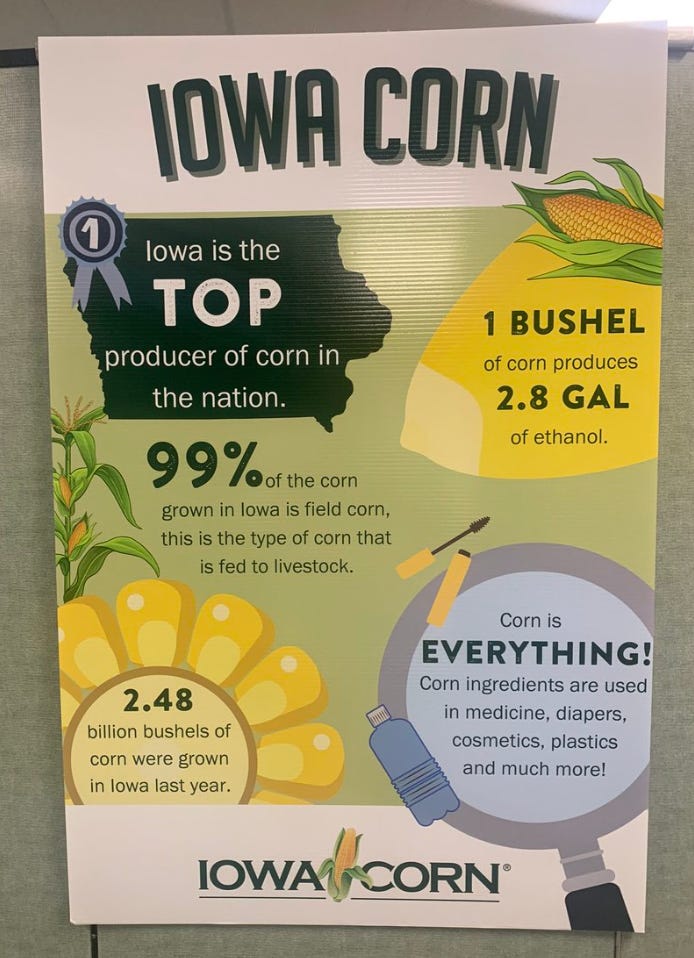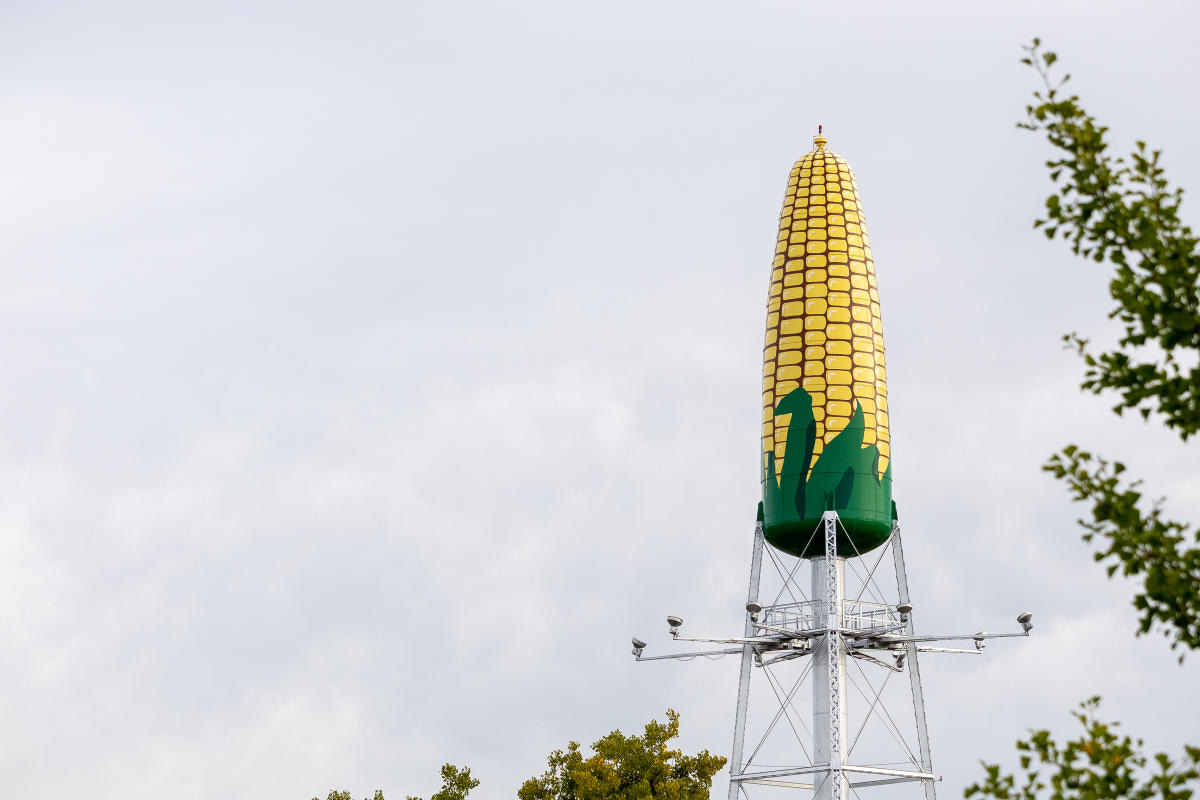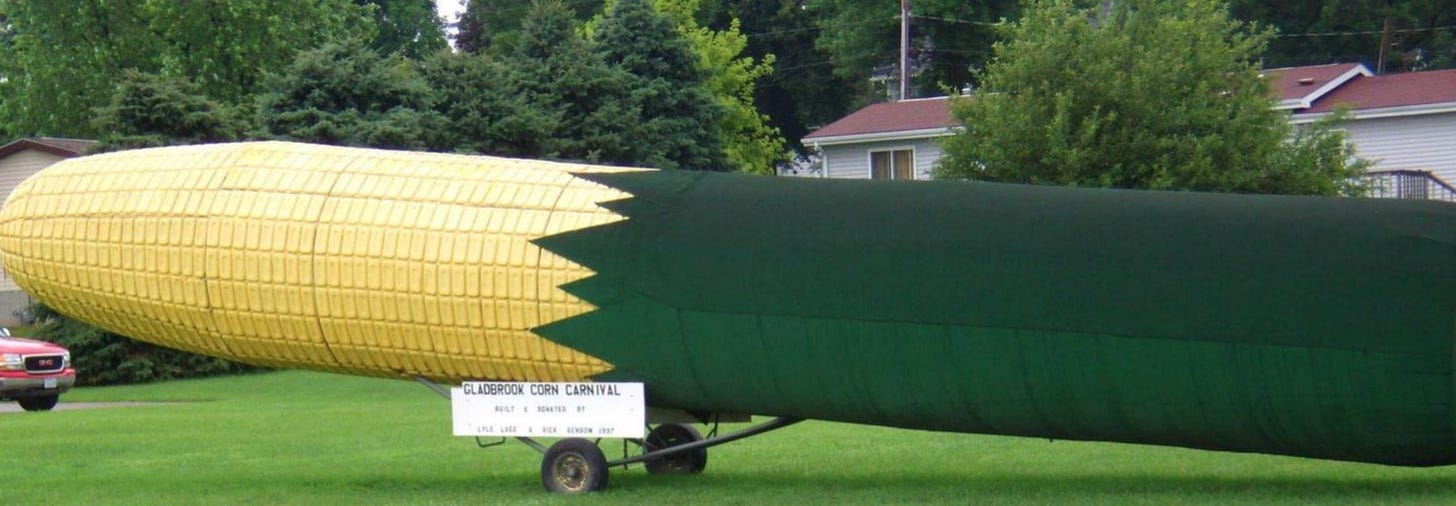Advertising sells a product; propaganda sells an idea. The food industry does a lot of advertising to entice you into buying their products, and the statistics describing the average American body these days show they’ve done a great job of it.
Agriculture, and especially corn belt agriculture, should not be conflated with the food industry because much of the organic carbon it produces is not consumed as food (calories going into fuel ethanol exceed the caloric needs of all 330 million Americans—calculation at end of essay). Growing plants and raising animals for food can be a noble endeavor, but as agriculture’s output trends evermore toward producing organic carbon for energy and not food, then the nobility of the task tends to erode away like soil in a Northeast Iowa downpour. To my point, literally nobody has ever said, “on the 8th day, God made an oil rig roughneck.”
Because of the environmental consequences intrinsic to agriculture (water and air pollution, habitat loss, soil erosion, altered hydrology, and climate change), there should be rock solid reasons for producing more than what the country needs. You can make the case that export is a rock-solid reason, if you can turn a blind eye to the fact that we’ve clearly damaged farming systems and cultures in some other countries through zealous efforts to ram our junk calories down their throats.
Industry titans and their political puppets long ago recognized that we likely could never export all our surplus corn. And to top it off, corn yields would only continue to increase going forward because the seed companies were never going to unfurl a Mission Accornplished banner. After all, share price, dividends, and CEO salaries are all super important in America. And let’s not forget that their crop geneticists like expensive vacations and scientific meetings in corn centers like Honolulu, and by god they didn’t spend years in poverty getting their PhD so they could study drought resistance in canola on the steppe of North Dakota.
Enter corn derived ethanol blended into gasoline, forced into American gas tanks beginning in 2005.
But there’s always been a big problem for the producers of ethanol—it’s hard to advertise it in way that is consistent with the fundamental physics of its production and use. Thus, the industry has had to resort to propaganda to maintain its beachhead on Gas Pump Island, promoting the idea that ethanol is a good choice for the consumer and the country, and especially, that it’s “green”.
Yet one more sample of this propaganda was sent to me this weekend, shown above. This is a poster adorning 4H buildings at county fairs occurring now around the state. The fact that the Corn Growers feel compelled to rationalize (propagandize?) their mission in the friendly confines of the THE BLOODY 4H BUILDINGS AT COUNTY FAIRS ought to tell you something. I just looove that “99% of Iowa corn is the type of corn fed to livestock.” Do people at Iowa county fairs really think field corn is for eating? Or are the Corn Growers trying to avoid the factoid that >50% of Iowa corn is fed to the ethanolians? Here’s a new suggested motto for the ICGA: “Cows could’ve eaten it!”
The poster says 1 bushel of corn produces 2.8 gallons of ethanol. Ok. Not disputing that. But the poster could just as accurately say that 56 pounds of corn can produce 19.6 pounds of ethanol, but then that takes the fun out of it, doesn’t it? I mean, who even knows anymore how big a bushel really is? At least the readers of this column now know it’s the volume occupied by 56 pounds of shelled corn. It’s also 60 pounds of wheat and soybeans, 30 pounds of sunflower seed, 56 pounds of sorghum, 45 pounds of apples, 34 pounds of oats, and 50 pounds of canola (rapeseed). You have to wonder what some of those numbers might be if all those crop geneticists didn’t have corn on their brain 24/7. But when your knees hit the floor tonight, thank the almighty that all that brain power is being used to squeeze off one extra bushel for ethanol.
Let’s deconstruct this a little further. Contained within those 56 pounds of corn is 300,000 BTU of potential energy. There are 237,000 BTUs in the 2.8 ethanol gallons (19.6 pounds) but according to Iowa State University, it took 27,000 BTU to grow that bushel of corn. So let’s drop 237,000 to 210,000 BTU, so you’re getting about 70% of the energy out of the corn and into the ethanol. The rest is mainly lost as heat or retained in residual material, some of which can be fed to cattle.

If you stopped there, it would make sense to turn corn into ethanol. But there are a myriad of items in the energy budget for corn ethanol, including quite a lot of energy needed to run the ethanol plant itself, energy to treat and pump huge amounts of water, fossil fuel to transport the corn grain to the ethanol plant, and many others, until when it’s all done and said we get about 1.3 units of energy out (i.e. ethanol and by products) for every 1 energy unit in (fossil fuel). That depends a lot on who you ask—it’s controversial. Anyway, 1.3 is a pretty safe number.
That metric for gasoline: 6 out/1 in.
Now you can argue which industry degrades the planet more at this point, corn agriculture or petroleum extraction. Ethanol comes with perhaps, perhaps (I meant to type it twice), a very modest greenhouse gas benefit but that is far from settled science. I can tell you this: if it were true, you wouldn’t see the three amigos (Bruce Rastetter, Tom Vilsack, and Terry Branstad) and their cronies trying to lay pipeline across the hinterland.
Now let me say for the record that I’m not against growing stuff for energy if the physics makes sense. For quite a few years we talked about growing switchgrass (Panicum virgatum) and giant miscanthus (Miscanthus sinensis x Miscanthus sacchariflorus) in Iowa for energy. The University of Iowa heating plant has burned the latter from local fields, but this has not caught on in Iowa or anywhere else for that matter. There is triple the energy in switchgrass compared to corn grain on a per acre basis. So why don’t we grow it? Your inner maize (all native Iowans have one) might tell you because it can’t be economically converted to a liquid fuel, which is true. But if your concern is climate change then it makes far more sense to grow these grasses for incineration and energy than it does to grow corn to displace 10-15% of gasoline use. A reasonable person might also say that since you don’t have to buy expensive seed every year for a perennial grass, you don’t have to fertilize it (although some do), it doesn’t require insecticides, herbicides, grain drying, crop insurance, planters, plows and other tillage equipment, there’s virtually no soil erosion and you don’t need to worry much about rainfall, that we would want to do this instead of corn ethanol. But many of those reasons are exactly why the Ag Titans and politicians don’t like it—they can’t sell all that stuff. And if the Ag Titans don’t want it, then you ain’t gettin’ it.
And, come to think of it, it’s tough to make phallic symbols and palaces and parade floats and water towers that look like switchgrass.
Calculation for corn ethanol calories vs US human population caloric needs
5.325 billion bushels of corn for ethanol (link)
76,000 k-calories in bushel of corn
5.325 billion x 76,000 = 404.7 trillion calories
333 million people in U.S.
Recommended average caloric intake for men: 2600 calories
Recommended average caloric intake for women: 2000 calories
Overall average caloric intake for men and women: 2300 calories
333 million x 2300 x 365 days = 279.6 trillion calories
Resources used
https://www.rayglen.com/crop-bushel-weights/
https://greentransportation.info/energy-transportation/gasoline-costs-6kwh.html
https://en.wikipedia.org/wiki/Gasoline_gallon_equivalent#cite_note-8
https://afdc.energy.gov/fuels/properties
https://www.livestrong.com/article/311970-how-many-calories-in-4-oz-of-pork-tenderloin/
http://bdss.tennessee.edu/Home/GetFact?cropType=Switchgrass
https://www.theguardian.com/media/2017/mar/11/death-truth-propaganda-alternative-facts-gripped-world
https://ask.usda.gov/s/article/How-much-corn-is-expected-to--be-used-for-ethanol-in-the-current-year#:~:text=The%20amount%20of%20corn%20used,Grains%20Sector%20at%20a%20Glance.











Also...feeding corn to cattle AKA a high energy ration...decreases the pH of the rumen and increases the risk of Shiga Toxin E. coli. Really...it is not that good for dairy or beef cattle. As for swine...in order for them to digest it, it has to be ground perfectly. Too coarse, it goes right thru, to fine and it gives them ulcers (which is true of any feedstock for them).
I loved your opening statement, "Advertising sells a product; propaganda sells an idea".